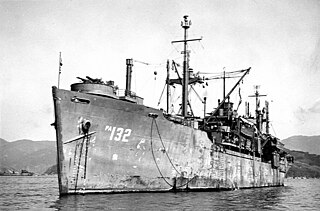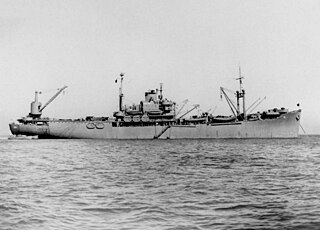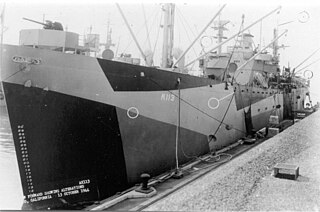
USS Altamaha (AVG-18/ACV-18/CVE-18) was an escort aircraft carrier in the United States Navy during World War II. She was named for the Altamaha River in Georgia.

USS Denver (CL-58) was a Cleveland-class light cruiser. Denver launched on 4 April 1942 by New York Shipbuilding Corp., Camden, New Jersey; sponsored by Miss L. J. Stapleton, daughter of the Mayor of Denver; and commissioned on 15 October 1942, Captain Robert Carney in command. It was the second ship named for the city of Denver, Colorado.

USS Arided (AK-73), a Crater-class cargo ship, is the only ship of the US Navy to have this name. She was named after Arided, the other name of Deneb, the alpha star of constellation Cygnus.

USS Lassen (AE-3) was built as MS Shooting Star under a U.S. Maritime Commission contract, was delivered to the U.S. Navy after sea trials, and became an ammunition cargo ship during World War II. Like many Naval ships of this category that carried large amounts of explosive cargo, she was named for a volcano. In this case, the ship was named for Lassen Peak, a volcano in northern California that erupted heavily in 1914–17.

USS Fuller (AP-14/APA-7) was a Heywood-class attack transport in service with the United States Navy from 1941 to 1946. She was scrapped in 1957.

The USS Albireo (AK-90) was a Crater-class cargo ship in the service of the US Navy in World War II and manned by a US Coast Guard crew. She was the only ship of the Navy to have borne this name. She is named after Albireo, a star in the constellation of Cygnus.

USS Alcyone (AKA-7) was an Arcturus-class attack cargo ship named after Alcyone, the brightest star in the star cluster Pleiades. She served as a commissioned ship for five years and one month.

USS Alchiba (AKA-6) was an Arcturus-class attack cargo ship of the United States Navy, named after Alchiba, a star in the constellation Corvus. She served as a commissioned ship for 4 years and 7 months.

USS Patuxent (AO-44) was a Kennebec-class oiler in the United States Navy during World War II. She was the second U.S. Navy ship named for the Patuxent River in Maryland.
USS Saranac (AO-74), originally named the SS Cowpens, was a Type T2-SE-A1 Suamico-class fleet oiler of the United States Navy, and the fourth ship of the Navy to bear the name.

USS Barnwell (APA/LPA-132) was a Haskell-class attack transport in service with the United States Navy from 1945 to 1947. She was sunk as a target in 1986.

USS Wharton (AP-7) was a troop transport in the service of the United States Navy during World War II. The ship was originally an Emergency Fleet Corporation Design 1029 type built for the United States Shipping Board. The ship was laid down as Manmasco but renamed and launched as Sea Girt then completed September 1921 as Southern Cross. The ship was first allocated by the United States Shipping Board to the Munson Steamship Line until purchased by the line in 1925. Munson operated the Southern Cross in the South American trade from 1921 until 1938 when the ship was sold at a Marshall's sale and taken over by the United States Maritime Commission which paid the full mortgage claim.

USS Pocomoke (AV-9) was a Pocomoke-class seaplane tender, originally built as the SS Exchequer and acquired by the U.S. Navy as the military build-up occurred in the United States just prior to World War II. She operated principally in the Pacific Theatre of the war and serviced military seaplanes. At war’s end, she returned to the United States with two battle stars.

USS Rutilicus (AK-113) was a Crater-class cargo ship commissioned by the US Navy for service in World War II. She was responsible for delivering troops, goods and equipment to locations in the Asiatic-Pacific Theater.
USS Zaurak (AK-117) was a Crater-class cargo ship commissioned by the U.S. Navy for service in World War II. She was responsible for delivering troops, goods and equipment to locations in the war zone.
USS Volans (AKS-9) was an Acubens-class general stores issue ship commissioned by the U.S. Navy for service in World War II. She was responsible for delivering and disbursing goods and equipment to locations in the war zone.

USS Adria (AF-30) was an Adria-class stores ship in service with the United States Navy from 1944 to 1954. She was scrapped in 1977.

USS Loeser was a Buckley-class destroyer escort of the United States Navy, named in honor of Lieutenant Commander Arthur E. Loeser (1903–1942).

USS Crescent City (AP-40/APA-21) was the lead ship of the Crescent City-class attack transports that served with the US Navy during World War II. The ship was built as the cargo and passenger liner Delorleans for the Mississippi Shipping Company's Delta Line. After brief commercial operation the ship was among 28 vessels requisitioned in June 1941 for the Navy and the Army. The Navy renamed the ship Crescent City, a popular nickname for New Orleans, Louisiana, upon commissioning 10 October 1941. The ship was decommissioned and laid up in 1948 before being loaned to the California Maritime Academy to serve as a training ship 1971–1995 and then transferred to a foundation in a failed art colony project. The ship left California for Texas scrapping in 2012.

USS George F. Elliott (AP-105) was a cargo liner built for the Mississippi Shipping Company as SS Delbrasil for operation between New Orleans and the east coast of South America in 1939 by its operator, Delta Line. The ship entered that service and operated until taken over by the War Shipping Administration (WSA) on 28 April 1942 for operation by Delta Line acting as WSA's agent. On 25 August 1943 WSA allocated the ship to the Navy for conversion to a troop transport commissioned and operated by the Navy for the duration of the war. Ownership of the ship was transferred from Mississippi Shipping to WSA on 4 February 1944 while under Navy operation and was retained until sale to American South African Lines on 22 December 1948. The ship was renamed African Endeavor until returned as a trade in to the Maritime Commission on 22 September 1960 for layup in the James River reserve fleet and later sold to Boston Metals for scrapping.


















